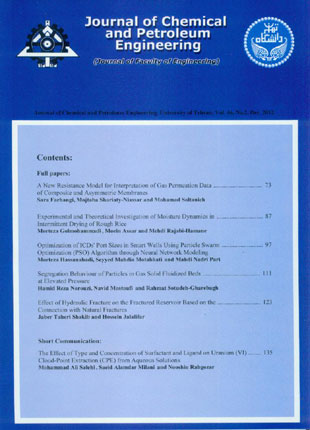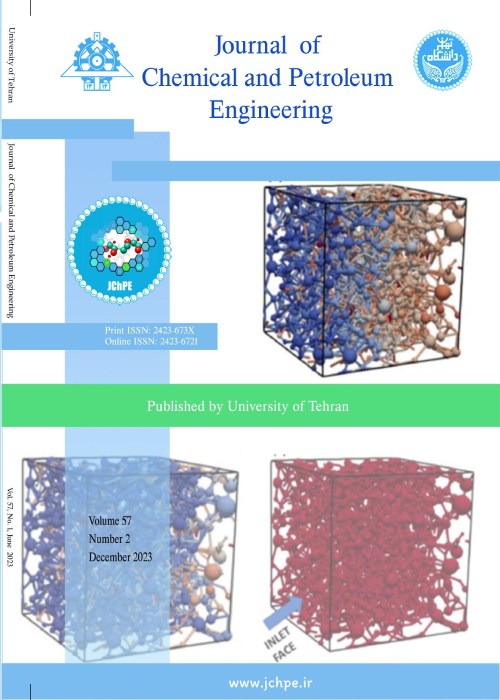فهرست مطالب

Journal of Chemical and Petroleum Engineering
Volume:46 Issue: 2, Dec 2012
- تاریخ انتشار: 1391/11/03
- تعداد عناوین: 6
-
-
New Resistance Model for Interpretation of Gas Permeation Data of Composite and Asymmetric MembranesPage 73In this work a new resistance model has been presented based on that of Henis-Tripodi which can be used for interpretation of gas permeation data in composite and asymmetric membranes. In contrast to the previous works, in this model the fraction of the support layer surface that includes the pores filled with coating material has been taken into account. The influences of the filled pores on separation factor and the gas permeation through composite and asymmetric membranes as well as the influence of the effective thickness of substrate on the filled pores have also been analyzed. Then the corresponding unknown parameters for gas separation of the composite and asymmetric membranes have been characterized by nonlinear regression and the results were compared with those of the experimental data from the literature. The pressure dependence of the gas permeability coefficient in glassy polymer has also been considered. The model shows improvement with respect to its capability in the interpretation of the permeation data of gas mixtures by composite and asymmetric membranes.Keywords: Gas permeation, Asymmetric membrane, Composite membrane, Resistance model, Coating material
-
Experimental and Theoretical Investigation of Moisture Dynamics in Intermittent Drying of Rough RicePage 87Intermittent drying is a satisfactory technique for drying of heat sensitive grains especially rough rice. This method consists of two separate stages applied intermittently: drying and tempering. In this work, intermittent drying of rough rice is investigated both theoretically and experimentally. In order to characterize this process; a multi-scale model consisting of macroscopic and microscopic submodels has been developed. Macroscopic model calculates the moisture changes of the rough rice bed assuming a lumped model for grains, while the microscopic submodel determines the rate of moisture gradient removal during the resting period. In latter submodel, moisture is assumed to diffuse through the grains governing by Fick’s law. Further, a set of experiments were designed and carried out in a lab-scale fluidized bed dryer to estimate the model parameters as well as to evaluate the effects of different parameters such as temperature, air velocity, and tempering time on the drying rate. The model estimates show good agreement with experimental data. Model's results reveal that thermal equilibrium is rapidly obtained within the first two minutes of grain-hot air exposure. Air velocity shows to have no significant effect on drying rate when fluidized condition is prevailed. In addition, a significant kink occurs in drying rate diagrams which implies that drying rate is improved as a result of moisture gradient removal by applying tempering period.Keywords: Intermittent drying, Mathematical modeling, Parameter estimation Rough rice
-
Page 97Oil production optimization is one of the main targets of reservoir management. Smart well technology gives the ability of real time oil production optimization. Although this technology has many advantages; optimum adjustment or sizing of corresponding valves is still an issue to be solved. In this research, optimum port sizing of inflow control devices (ICDs) which are passive control valves is focused on by designing a neural network to simulate reservoir behavior and applying Particle Swarm Optimization algorithm to find optimum port size for ICDs. Indeed; this work eliminates the need for lots of expensive and time consuming iterations through reservoir simulator. The objective of the work is to maximize the oil production.Keywords: Inflow control device (ICD), Smart well, Artificial neural network (ANN), Particle Swarm Optimization (PSO), Optimization
-
Page 111A comprehensive mathematical model based on the discrete particle model and computational fluid dynamics was utilized to investigate mixing and segregation of particles in fluidized beds at high pressure. To quantify the extent of mixing in the bed, the Lacey mixing index was used. Simulations were carried out with different mass fractions of small particles at various pressures ranging from 1 to 64 bar and at various superficial gas velocities. The results showed that the bed transforms from a segregated state to a fully mixed condition when the operating pressure is increased. Vertical segregation of particles at low pressure was replaced by horizontal segregation of particles at high pressures in which small particles were collected mainly near the walls and large particles at the center of the bed. At the same pressure, the rate of segregation decreased with increasing the mass fraction of small particles.Keywords: Mixing, Segregation, Fluidized bed, Lacey index, Discrete particle model
-
Page 123Hydraulic fracturing in the fractured reservoirs plays a significant impact on the production rate. In this study, the hydrostatic condition is taken into account, the hydraulic fracturing operation was applied in every direction usinga written distinct element code. In each direction the hydraulic fracture is applied with different lengths and in each level the amount of production is predicted. The impact of interaction of natural fractures and hydraulic fractures on the amount of production is discussed and the number of natural fractures which are intersected by hydraulic fractures is presented. Hydraulic fracturing operation in different directions with different lengths is economically analyzed. In fractured reservoirs the best scenario is that the hydraulic fracture is created in a direction that intersects a group of high permeable natural fractures/parts of the reservoir that are actively participating in flow or the parts with high pore pressures and no connection to the well. The reason isthat connecting the natural fractures which are near the well does not have a significant effect on the production rate. According to the results, creating the hydraulic fractures in a direction with no fractures significantly affects the production rate.Keywords: Fluid flow, Hydraulic fracture, Natural fracture, Pore pressure, Production rate, Stresses
-
Page 135In this article cloud-point extraction (CPE) was used with chelating agent to extract uranium from aqueous solutions. The methodology used is based on the formation of metal complexes soluble in a micellar phase of surfactant. The metal ions complexes are then extracted into the surfactant-rich phase at a temperature above the cloud-point temperature. The effect of type of surfactants and ligands on extraction efficiency at constant condition (pH =6, surfactant concentration of 0.5 % (w/v), chelating agent concentration of 1.5 × 10-3 M, incubation time of 20 min, equilibrium temperature of 50˚C, centrifugation time of 10 min) were studied and the best surfactant and ligand was identified. Then, optimum concentration of surfactant and ligand together with the other optimal conditions of extraction was determined. By using CPE method and obtained optimal conditions, determination of uranium in water samples with a detection limit of 0.15μg L-1 was conducted.Keywords: Cloud, point extraction, Uranium, Triton X, 114, Triton X, 100, CTAB, 8, HQ, SDS, PAN, DBM, Br, PADAP


